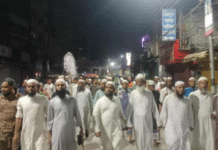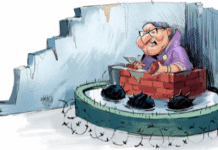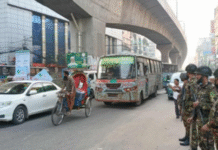Rabindranath and Dhaka University

The story of Rabindranath’s opposition to the establishment of Dhaka University is not supported by any solid evidence
Bengali Muslim intellectuals, political activists and litterateurs who put faith in the ideology of Pakistan considered Rabindranath a strong barrier to the creation of a Muslim nationalist culture. Their main argument was that Rabindranath’s literature and songs were steeped in Hindu idolatry beliefs and, therefore, anti-Islamic. There were official attempts to excise him from radio, television and textbooks when Bangladesh was part of Pakistan but they failed to banish him, though a number of Bengali Muslim litterateurs supported the government position through an open statement.
Rabindranath was also condemned by a totally different entity – the orthodox communists. In the 1940s – at the height of a Stalinist/Zhadanovian ideological hegemony – Rabindranath was branded by a section of ideologues associated with the communist movement as a reactionary feudal-idealist whose literature and music were thought to be harmful to the revolutionary consciousness of the working classes. In present-day Bangladesh, the Muslim nationalists – though they no longer speak in the voice of the Pakistanis – are very active and some of them pose as progressive-secular intellectuals. On public forums and social media, they cleverly say that Rabindranath was anti-Muslim and his opposition to the establishment of Dhaka University is the proof of his hostility to Muslims.
The truth is, the story of Rabindranath’s opposition to the establishment of Dhaka University is not supported by any solid evidence. Rabindranath is one of the most researched persons in Bangladesh and India. But there is not a shred of evidence on this in any archive on Rabindranath. While many of the crypto-Muslim nationalists speak on this theme in workshops and learned gatherings and post blogs on Facebook, we get the most detailed narrative on the subject from Major General (Retd) MA Matin in his book, titled Amader Swadhinata Sangramer Dharabahikata ebong Prasangik Kicchu Katha (Ahmad Publishing House, Dhaka, 2000). General Matin presents the story as follows:
“Hindu leaders organized protest meetings and mobilizations all over Bengal against the establishment of Dhaka University. A huge meeting was organized at Garer Math in Kolkata on March 28, 1912 to protest the establishment of Dhaka University. It was presided over by poet Rabindranath Thakur. It should be mentioned here that a personality like poet Rabindranath Thakur also opposed the establishment of Dhaka University. Because Rabindranath was a Hindu swabhabkobi steeped in Hindu mentality and Hindu consciousness and indoctrinated in Hindu ideas. For this reason, he could not accept the proposal for establishing Dhaka University by rising above a narrow communal outlook at that time. Moreover, many of the erstwhile leaders of Kolkata University were Hindu including poet Rabindranath, and were zamindars who contributed financially to establish Kolkata University. Their zamindaries extended over to East Bengal and they thought that a new university in East Bengal would reduce the importance of Kolkata University and they would not have as much influence on Dhaka University as they had on Kolkata University … they argued that the majority of the population of East Bengal are Muslim peasants and, therefore, there was no need to establish a university for the higher education of their children … Furthermore, a high-level delegation of Hindu leaders met Viceroy Lord Hardinge and expressed the opinion that the establishment of Dhaka University would be comparable to an internal partition of Bengal because this would divide the Bengali nation and aggravate the animosity between the Hindus and Muslims.” [my translation]
Yet, Major General (Retd) Matin has not cited the source of information he has provided nor given any reference in his book.
Interestingly, the Tagore archives present a different picture. On March 28, 2012, Rabindranath was at Shilaidaha in Kushtia. He left Kolkata on March 24 and stayed at Shilaidaha till April 12, recuperating from illness for which he had cancelled his journey by ship to England scheduled on March 19. Rabindranath used to put dates and notes on places of composition at the end of every poem/song lyric, and the 18 poems and songs composed during those days have the place-name Shilaidaha. One specific poem (number 4 in the anthology Gitimalya) was dated March 28, 2012. So he could not be present at two places nearly 80 miles apart on the same day, ie Garer Math in Kolkata and Shilaidahain Pabna.
Apart from evidential inconsistency that exposes his story, General Matin in his blind hatred toward Hindus and Rabindranath also forgot to follow the chronology of events leading to the establishment of Dhaka University. We know that Dhaka University was established on the basis of the recommendations made by the Nathan Commission appointed by the Government of Bengal on May 27, 1912. The Commission’s report was approved by the Secretary of State for India in December 1913. However, its recommendations could not be implemented due to the outbreak of the First World War (August 4, 1914 – November 11, 1918) as the war efforts were then the British Government’s priority and the Dhaka University scheme was shelved. Later the Government of India appointed the Sadler Commission in November 1917 to investigate the problems affecting Kolkata University and revisit the Nathan Commission’s recommendation on establishing Dhaka University. The Sadler Commission submitted its report to the government in March 1919. Based on the Commission’s recommendations, Dhaka University was established in 1921.
According to General Matin, the meeting protesting the establishment of Dhaka University was held at Garer Math in Kolkata on March 28, 1912 – two months before the Nathan Commission was appointed. If General Matin is to be believed, then it must be admitted that Rabindranath and his Kolkata Hindu Bhadralok cohorts were prescient about the Nathan Commission’s recommendations through some miraculous power.
Needless to say, Dhaka University has been viewed as an educational institution for Muslims by the learned general, though how an institution of higher education modeled on Oxford University could take the character of a school for Muslims has not been explained. The general also forgets that it was in British Bengal that Dhaka University was established and East Bengal was not treated by the British and the Bengali Muslims as a Muslim country like Pakistan. It is clear that the general and his fellow Muslim nationalists suffer from the delusion of putting the present in the past.
It remains to be seen how the general and his companions would explain the establishment of the school of Islamic History and Culture at Shantiniketan by this anti-Muslim Hindu poet with the generous financial assistance of a Muslim ruler of an Indian state, the Nizam-ul-Mulk Mir Osman Ali Khan of Hyderabad.
The fact is, the opposition to the proposal for the establishment of Dhaka University came mainly from Ashutosh Mukherjee, Vice Chancellor of Kolkata University (1921-1923). He thought that a new university would substantially reduce his vast constituency and authority and the existence of a rival institution within the “same country” was uncomfortable to him.
The argument that “Dhaka University would benefit the Muslims” is not based on facts because Kolkata University and Presidency College were equally open to Muslims and several districts in West Bengal had a large Muslim population. Similarly Dhaka University also benefitted the Hindus of East Bengal. Many famous Bengali Muslims were native to West Bengal and educated at Kolkata University and Presidency College. The secretary general of Bengal Muslim League (1943-1947) Abul Hashim (1905-1974) was from Burdwan and was educated at Kolkata University. His father Abul Kasem (1872-1936) graduated from Presidency College in 1894 and was a Congress leader. Abul Kasem was also a member of the Senate of Dhaka University. Huseyn Shaheed Suhrawardy (1892-1963), the prime minister of Bengal (1946-47) and later Pakistan (1956-57), was from Medinipur and graduated from St Xaviers College in Kolkata. His maternal uncle Hassan Suhrawardy (1884-1946) was vice chancellor of Kolkata University (1930-34).
Mohammad Akram Khan, Dr Muhammad Shahidullah (a lecturer at Kolkata University and later at Dhaka University), Dr Muhammad Kudrat-e-Khuda (head of Chemistry, 1936, and principal of Presidency College, 1946-47) were respectively from 24 parganas and Birbhum. Sir Azizul Huque (1892-1947), vice chancellor of Kolkata University (1939-43) was from Nadia. Justice Syed Mahbub Morshed (1911-1979) was from Murshidabad in West Bengal. Similarly, many brilliant and famous East Bengali Muslims also did not face any problem studying at Kolkata University and Presidency College. Other examples are Humayun Kabir (1898-1969) and Qazi Motahar Hossain (1897-1981) from Faridpur, Dr Mohammad Enamul Haq (1902-1982) from Chittagong, and Principal Ibrahim Khan (1894-1978) from Tangail, to name a few.
It is possible that another event has been deliberately used to concoct this Rabindranath’s “opposition to Dhaka University” story. Rabindranath supported the movement against the “Communal Award” (August 16, 1932) that established separate electorates for the religious minority communities, various castes and tribes of India. Congress vehemently opposed the Award but Muslim League accepted it. Rabindranath participated in the meetings held in Kolkata to protest the Award and was a signatory to the appeal to Viceroy Lord Willingdon (1931-36) for its repeal.
During his visit to Dhaka from February 7-14, 1926, Rabindranath stayed for the first three days as a guest of the Nawab of Dhaka Khwaja Habibullah and lived in his house-boat on the Buriganga River, spending the last three days in Jagannath Hall provost RC Majumdar’s residence. Rabindranath was given three receptions at Dhaka University. The first two were organized by Dhaka University Students’ Union (DUCSU) and held at Curzon Hall, and the third one was held at Salimullah Muslim Hall organized by Muslim students. Dhaka University Vice Chancellor Professor GH Langley presided over all three events. If Rabindranath had opposed the establishment of Dhaka University, it was unlikely that the Nawab of Dhaka and the Muslim students of the university would extend such warm hospitality and accord such a rousing reception to him. Dhaka University also conferred on him a D Lit degree during the 1936 convocation but he could not attend the ceremony due to illness.
Asahabur Rahman is a retired civil servant who currently works as a consultant to the World Bank, Dhaka. He studied Sociology at the University of Reading, UK and Dhaka University from where he received his Masters degree in 1970. He has written research articles and several books on Bangladesh’s peasant society, culture and history in both Bangla and English.









